25th December 1941 (Thurs cont)
David MacDougall, secretary to the Far Eastern Bureau of the Ministry of Information, along with his assistant Ted Ross, had been kept fully employed throughout the battle. With an estimated one and a half million Chinese in the Colony it had been vital for the Ministry to work with Admiral Chan Chak to counter the well organised fifth column propaganda.
Ted Ross MoI "The newspapers, both English and Chinese, had worked marvelously. When the power went off on December 18, they turned out their editions by hand press, and on one occasion an English newspaper editor ran over to our office when his hand presses were knocked out and got out a last edition on our mimeograph machine.
Right up to the last day there were three English newspapers and about five or six Chinese newspapers
still publishing.
Due to severance of all outside communication, we couldn't even get radio news broadcasts, the editions of the last week were simply single sheet affairs carrying local news and special notices.
Keeping the internal situation under control was as urgent as the actual fighting” [28]
The South China Morning Post "Day of good cheer. Hong Kong is observing the strangest and most sober Christmas in its century-old history." [62]
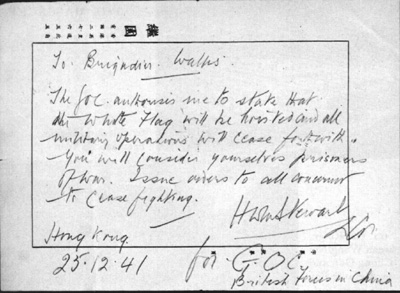
Left: Surrender Order
The order reads
- To Brigadier Wallis
- 'The GOC authorizes me to state that the white flag will be hoisted and all military operations will cease forthwith. You will consider yourselves prisoners of war.
- Issue orders to all concerned to cease fighting.
- H.W.M. Stewart, Lt. Col Hong Kong
- 25.12.41 for GOC
- British Forces in China.
Getting Away from Queens Road Central
Sq-Ldr Max Oxford RAF "Things looked black on Christmas morning and after a dash up to the Peak to evacuate some women and children I struck down to BHQ." [30]
Maj Goring GOC3 BHQ "At 2.45pm the Commodore (Capt Collinson RN) strode into the operations room, picked up the phone, called Aberdeen Harbour, and gave orders that the motor torpedo-boats were to sail instantly. I looked up from my work, and the Commodore smiled at me rather sadly. 'Sorry', he said 'but they've got to go at once. They'll be sailing in five minutes! Five minutes in which to get the Admiral (who had a wooden leg) down three flights of stairs, into a car, and along eight miles of road to Aberdeen! Forthwith I grabbed my phone. 'Bill' I said to the policeman. 'Scram like blazes! get the Admiral to Aberdeen in five minutes, and step on it'. 'Right' returned Bill. 'And where shall I meet you?' 'Scram' I roared, and slammed down the phone." [17]
At 15.00 the General gave the go-ahead to the staffies who had earlier sought permission to flee the Colony. Max Oxford left immediately and hurried down to Chan's office on the 2nd floor at 24-32 Queen's Road Central, the Shell building, on the corner with Pedder Street. There he met Bill Robinson with the Admiral. Chan Chak also had a private office on the 4th floor of the Pedder Building where he usually slept..
A party of British colonial officials, headed by governor Young, crossed the harbour to surrender on the third floor of The Peninsula hotel. [74]
Oliver Lindsay, Author "As the surrender was ordered, the Battle Box of Fortress HQ gradually emptied, and the group of officers finalized their escape plans. They asked Captain Ian MacGregor to persuade General Maltby to accompany them. The ADC went to his very weary and dispirited General. 'Sorry Ian,' Maltby said 'a Commander should not desert his men. I must stay with the Garrison, come what may. The others have my permission and approval to get away as planned." [80]
Signals between Lt-Cmd John Yorath, the Extended Defence Officer, XDO, and Gandy continued all afternoon
Lt-Cmd Yorath RN (Rtrd) XDO "At 15.35 I sent another signal "Go all boats." [15]
Lt- Cdr Gandy RN (Ret) (MTB 10) "As I had not got the two important Chinese passengers, Admiral Chan Chak and Colonel S-K Yee on board and had no news of them, and as also as movement by daylight would be obvious to the enemy, I consulted with Mr FWK with whom I had been told by the Commodore and XDO to collaberate closely in the matter of escape from Hong Kong and I decided to wait, delay being of mutual advantage." [15]
Sq-Ldr Max Oxford RAF "I had already asked the General’s permission to try and escape and at about 3p.m. he told me and three other Staff officers to go if we could." [30]
It was a warm sunny afternoon, with the sound of sporadic gun-fire coming from the Wanchai district as the enemy steadily advanced towards the city centre when Maj Goring told Macmillan to go. Macmillan gathered himself together and made for the exit. Guest and Macmillan climbed the steps out of BHQ to the bright sunshine outside. They then dashed across Garden Road to St John's Cathedral shortly after Oxford.
Capt Freddie Guest BHQ First we made our way along the passageway behind the HQ which had, incidentally, become a death-trap owing to the attention some Fifth Column sniper had been paying to it, then onto Garden Road.
We managed to get to the church without incident, and took cover in the churchyard for a much needed breather." [29]
Once in the Churchyard Guest and Macmillan removed their tin hats and tunics to look less conspicuous, before making a dash down Battery Path to Queens Road at the the junction with Icehouse Street. From there it is less than two hundred yards along Queens Road to Chan Chak's offices on the 2nd floor of Shell House.
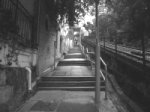 Capt Freddie Guest BHQ "I slipped off my uniform jacket, also my tin helmet, tucked them under my arm and made my way down the steps. Our next effort was to try to cross Queens Road, which is the main thoroughfare. We decided we had better cross the road one at a time, the idea being to make ourselves as inconspicuous as possible.
Capt Freddie Guest BHQ "I slipped off my uniform jacket, also my tin helmet, tucked them under my arm and made my way down the steps. Our next effort was to try to cross Queens Road, which is the main thoroughfare. We decided we had better cross the road one at a time, the idea being to make ourselves as inconspicuous as possible.
Left: Battery Path
Everywhere there were signs of cast-off badges of office of all kinds armbands of all descriptions, of volunteer work; ARP, Special Police, Ambulance Badges, tin hats by the dozen and plenty of gas masks." [29]
Adm Chan Chak ROC "At about 3pm, received the phone call from the Hong Kong Governor, he told me that the torpedo boats were ready and asked me to lead the senior officers of the British army to Aberdeen, take the boats and flee Hong Kong.
The Commander (CS Gimson?) arrived just when I was ready to leave, we went downstairs together and there were two cars parked at the front entrance, sitting in there were Guest, Oxford, Robinson, Macmillan, Ross, MacDougall". [6]
Maj Goring GOC3 BHQ "I wasn't going to meet anyone anywhere; our cherished plan had miscarried." [17]
MacDougall and Ross had prepared knapsacks/haversacks beforehand, as had Robinson. It is most likely that the Commander that Chan refers to was Colonial Secretary Franklin Gimson, confirming that hostilities had ceased forthwith. They were now free to go.
They all came down the stairs and out onto Queens Road. Hsu Heng (Henry) had a soft-topped Austin ready outside the offices while Ted had his Buick parked over the road outside the Kings Theatre.
Philip Snow, Author "There now followed a getaway worthy of a sequence in a James Bond film." [68]
 Capt Freddie Guest BHQ "The Admiral was in ordinary Chinese clothes and carried a very small hold all with him. Henry, his right hand man, a most likable fellow, was also in Chinese clothes and also carried a small hold all. Colonel Yee was in Chinese clothes and carried a bag.
Capt Freddie Guest BHQ "The Admiral was in ordinary Chinese clothes and carried a very small hold all with him. Henry, his right hand man, a most likable fellow, was also in Chinese clothes and also carried a small hold all. Colonel Yee was in Chinese clothes and carried a bag.
Macmillan and myself both still wore British uniform and carried just the few things we had been able to lay our hands on, in our pockets.
There was the Admiral, the Chinese Colonel, S.K. Yee, Lt-Cmd Hsu Heng (Henry), with Henry driving the car." [29]
Adm Chan Chak ROC "
S.K. Yee, Hsu Heng, Yeung Chuen and I got into the car, a party of more than ten people, riding in two cars, heading west to Aberdeen.
It was past 3.30pm on December 25, the 30th year of The Republic of China." [6]
Lt-Cmd Hsu Heng (Henry) ROC "Yes, they were in the second car. I was the driver of the first car. In total, we all had about dozen of people." [7]
Antony Beevor Author "The British became rather fond of the piratical Chinese Admiral who had saved the situation, and they finally agreed to seek help from Nationalist armies." [57]
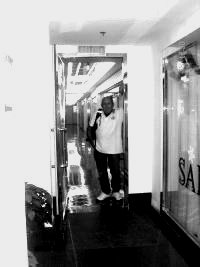
Sq-Ldr Max Oxford RAF "We collected the Chinese and drove to Aberdeen, on the south side of the island, it had become the temporary naval base and the M.T.B.'s should be there." [30]
Ted Ross MoI "We dashed out onto Queens Road, where the trusty old Buick was parked just in front of the King's theatre. There we were joined by the party of four official Chinese (they had not contacted the torpedo boat before the surrender, and our hopes rose that perhaps the boat would still be waiting) and British officers who realised the jig was up and were anxious to attempt the escape with us.
Left: The author in Adm Chan Chaks private office on the 4th floor of the Pedder Building.
The strange thing was that part of the city was completely deserted, everyone had disappeared off the streets, there was nobody there ....I was driving the lead car and I shot across Pedder street down Queens Road ...I hadn’t gone more than a few hundred yards, to just past the King’s Theatre, when ‘Two Gun’ jumped out.” [28]
The two cars set off westward along Queens Road, past the Queens Theatre and Jimmy's Kitchen in Theatre Lane with Henry in the lead when they stopped to speak to Morris 'Two Guns' Cohen, known by the Chinese as Mah Sam. He He declined to join them, saying he would take his chance with the Japanese, then sauntered off up the road. [28]
Two Guns Cohen was interned at Stanley, but released in a prisoner exchange for important Japanese officials held in the USA late in 1943.
Sub-Lt Lewis Bush HKRNVR (late MTB 08) "General Two Guns Cohen, once a bodyguard for Dr Sun Yat-sen, had been given a bad time by the Kempei."
David MacDougall MoI "As we left town we heard the rattle of machine gun fire as the enemy forced his way into the central district." [26]
Ted drove on, leaving the city behind they drove on past the Queen Mary Hospital, negotiating burned out hulks littering the road. Tthey saw many bodies of Chinese men, women, and children beside the road. [42]
Ted Ross MoI "“I just gunned it - there was no traffic, there was nothing. And we shot right around past the University, past the Queen Mary hospital down to Aberdeen.” [28]
Adm Chan Chak ROC "On the way to Aberdeen, we saw that the residents were still calm, they did not know that the Governor of Hong Kong had already decided to give up Hong Kong. The British army sentries near Queen Mary Hospital were still in position. It was life as usual." [6]
Unbeknown to them they drove right past two of the MTB's (07 & 09) under camouflage in Telegraph Bay, eventually arriving in a deserted Aberdeen at 1615. The weather had been warm with bright sunshine all day. The crew members maintaned their daily routine with ablutions, by taking their routine dip in the warm South China Seas using sea soap.
Lt-Cmd Hsu Heng (Henry) ROC "When we drove along the coast in Aberdeen, there were a lot of dead bodies covered by mats and no one collected them." [7]
 L/S Les Barker (MTB 11) "We hid behind Aberdeen, on the western end of Hong Kong Island until nightfall, camouflaged under trees which hung into the water." [24]
L/S Les Barker (MTB 11) "We hid behind Aberdeen, on the western end of Hong Kong Island until nightfall, camouflaged under trees which hung into the water." [24]
Left The MTB crews taking their daily dip
Colin McEwan SOE (MTB 11) "We were indeed
so sheltered that, in the afternoon, we managed to have a swim — albeit in
somewhat oily water. Still, as the C. O. (Lt Collingwood HKRNVR) remarked, it
would keep the mosquitoes away." [11]
Maj Goring GOC3 BHQ "An hour and a half later I knocked at the General's door and went in.
My information was that the enemy was within 400 yards of Headquarters on three sides. The General was smoking a cigarette and reading a magazine. He glanced up. 'Hullo!' he said quietly in some surprise. 'You oughtn't to be here. The Governor ordered the cease fire an hour ago, and we are now waiting for the Jap's to come and lead us away.'
I think I must have goggled; then I pulled myself together, trying hard not to be melodramatic. 'In that case, Sir, I'll say good-bye! 'Are you going to try to escape?' he asked, as he held out his hand. 'Well good-bye and good luck!" [17]
After climbing up the steps rising fifty feet from the underground Battle Box HQ, Goring could see Japanese troops coming down from the peak. It was a warm sunny afternoon as he hurried down Garden Road with the ominous sound of sporadic gun-fire coming from the Wanchai district as the enemy advanced towards the city center.
Maj Goring GOC3 BHQ "When I emerged from Battle Headquarters there was a good deal of bombing and shelling going on and the Cathedral (St John’s) was in trouble.
I walked past it, then past the Bank of China hoping to find a car which I might drive to Aberdeen. The Japanese were about 400 yards behind me and I could see columns of them descending the Peak to my left and front. When I reached Ice House Street, round the corner came an Austin seven saloon, driven by a private of the Royal Scots.
Hailing him, I asked where he was going. I'm trying to find A.R.P. headquarters Sir, he told me. I pointed towards the Gloucester Hotel. A.R.P. Headquarters is over yonder, I said, but I am very anxious to get to Aberdeen. Could you take me there? Jump in, Sir, he replied, and I scrambled in almost on top of his Sealyham terrier." [17]
Aberdeen
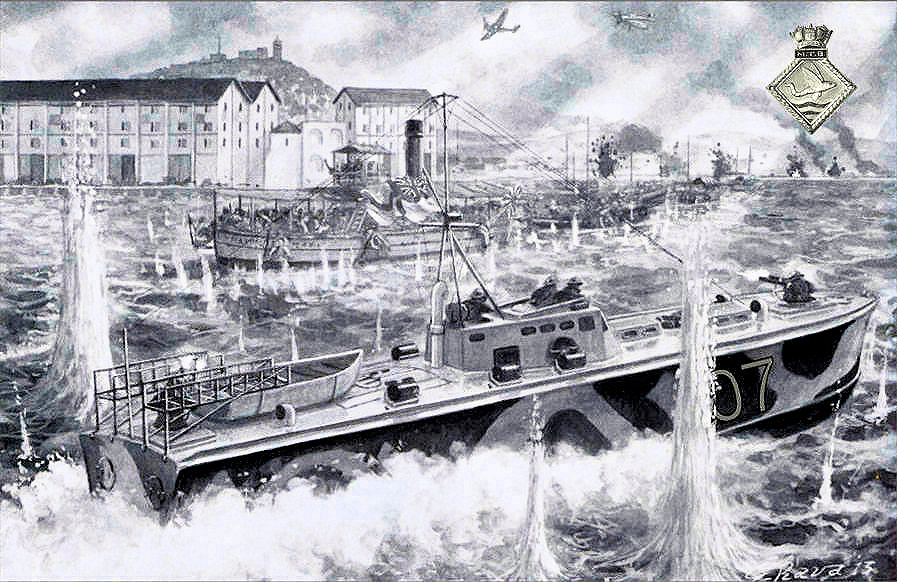
Adm Chan Chak ROC "When we arrived at Aberdeen, there was one speed boat waiting for us. The other boats were instructed to wait for us away from the shoreline." [6]
David MacDougall MoI "At Aberdeen we learned that it was all over; the colony had surrendered at 15:15. This left us free to board the speedboat – if we cd find it." [26]
The senior officer Aberdeen, late Boom Defence officer Kowloon Boom Depot, Cdr Hugh Montague RN (Rtrd) had been expecting the Chan party earlier. [106]
Cdr Montague RN (Ret) SNO Aberdeen "At 16.15 on the 25th December, His Excellency Admiral Chan Chak, accompanied by members of his Mission, and by officers from Fortress Headquarters arrived at the Naval Base, Aberdeen, in order to proceed to Mirs Bay in the boats of the 2nd MTB. Flotilla, according to pre-arranged plans.
I was most surprised to see them, as I had already passed orders to the Flotilla to go. The only boat immediately available was a motor boat belonging to the Cornflower. She had insufficient range to make the passage to Mirs Bay, but could take the party to the MTB's if they were nearby." [1]
HMS Cornflower, a 1175 ton sloop, was loaned to the Hong Kong government on 31/3/1934 as an RNVR Drillship. Sold in 1940 and renamed Tai Hing.
Repurchased in September 1940 and renamed HMS Cornflower (II). The Cornflower had been moored south-west of the RHKYC on Kellett Island in Causeway Bay since the nineteen thirties. [110]
Capt Freddie Guest BHQ "Presently another car came along and stopped and out stepped two Britishers. One turned out to be Major Arthur Goring, an Indian Cavalry officer on the General's staff who had been sent from H.Q. Delhi some months before." [29]
Warrant Officer Proulx had been a stock broker in civi street and was looking for his chum, Lt Ron Ashby of MTB 07, a former transport director of Dodwell & Co Ltd. They had enjoyed many long weekends fishing, shooting and sailing together before the invasion. Proulx missed the boat and was interned as a POW by the Japanese before escaping from North Point POW camp the following month with two Dutch submariners Hordyke and Idema who had only arrived three days earlier after being captured in Saigon. [49] p715/6
(W-O Benny Proulx) "I was prowling along waterfront then looking for you (Ashby) in the hopes of getting away with you. I was at Aberdeen then.
I did not like the food or service, without my boy in goal so decided to push off. I got away from North Point prison in January.
I went through the towns you passed through and a Chinese General showed me a photo of you and the group of 60 or 80 naval chaps who went through with the Admiral. I knew then you were okay.
When I think of those warm sunny Sunday mornings up at your bungalow at Stanley, the fishing and your yacht and all that, it makes me wish for the good old days of peace." [5]
Sub-Lt Lewis Bush HKRNVR (late MTB 08) "HMS Aberdeen was like a tin can floating in a pond and being pelted with stones by a host of boys; a few more bulls-eyes and it would be all over."
Maj Goring GOC3 BHQ "When we got there Aberdeen was under heavy shell-fire from enemy guns firing over open sights. We pulled up in the lee of a wall and I got out. 'Look lad,' I said to the driver. 'The garrison has surrendered. I am going to try to escape across to China. Would you care to come with me?' But the Royal Scot replied that he couldn't swim, and thought he'd better go back and look for A.R.P. Headquarters. With that he drove off; I felt terribly alone.
I stood there for a moment, looking at the up-ended shipping in the harbour, watching the shells bursting in the water. Then I heard my name called. I swung round and there was Admiral Chan Chak standing in a doorway." [17]
Ted Ross MoI “We saw a boat tied up to the pier, so I pulled up there and ran down to the boat and said “Have you seen an MTB around here?” There were a couple of Englishmen working on this boat and they said no, it was here but it’s already taken off.
So I went back to the car and said to MacDougall “It looks like the bloody MTB’s taken off before we got here. So MacDougall said ‘well drive us up the hill’...only five or six hundred yards away - that’s where the naval commandant was.
We got a hold of Commander Montague - he was a great fellow, a retired naval captain. He said ‘I’m afraid it’s gone (the MTB)’. MacDougall said ‘we’re escaping, we’ve got the Chinese Admiral and we’ve got to get out of here’ Montague said ‘Well there’s that little boat down there but it’s not much of a boat.’
He said ‘if you can wait 4 or 5 hours when the high tide comes in we’re going to re-float the boat (C.410) that we’ve been using to run the supplies into Stanley and that’s a good substantial boat.” [28]
Eddie Brazel HKRNVR (C4.10) "On Xmas Eve night we had several jobs to do, the last being to run Xmas comforts to troops holding an AA post that had been cut off by the enemy. Well to cut a long story short, as we proceeded out to fulfil our mission, about 01.30 on Xmas morn we went aground and in spite of all our efforts we were unable to get her off.” [46]
After destroying all the mine stations the Warrant-Officers from the Mine-Watch department, including Morley-Wright were mobilized into Royal Navy Divisions (RND) at Stanley Fort to fight alongside the army as infantry. Wright, wearing a boilersuit over his uniform, was captured along with others.
Capt Macmillan BHQ "At that time the Japs who took them prisoners were heavily engaged with our troops who recaptured the hotel garage in which they were, and they were thus rescued." [17]
Warrent Officer Wright made his way to Fortress HQ, where he was interviewed by Maj Goring, the GSO3, about the situation at the Repulse Bay Hotel before proceeding to Aberdeen with his colleague Benny Proulx.
There he and Sub-Lt JJ Forster began working on a 25 ft motor launch alongside the pier by Hope Dock, just west of Staunton creek. JJ knew it well as it was off HMS Cornflower where he had served as 1st Engineer.
Cdr Montague RN (Ret) SNO Aberdeen "Captain Damsgaard (Danish Cable Ship Store Nordiske (2)) Warrant-Officer W M-Wright HKRNVR, Messer’s D. Harley, JJ Forster, and H Christensen volunteered to man the boat, I instructed them to take the party to the MTB's in either Sandy Bay or Telegraph Bay. If the MTB's had left they should wait near the western end of Ap Lei Chau Island, out of site of the Japanese batteries until dark, when I would bring the diesel launch C.410 out to take the party to Mirs Bay. C.410 had been used to take ammunition to Stanley the previous night and had run aground in Aberdeen Channel. We hoped to re-float her at high water." [1]
Holger Christensen, a twenty one year old cadet, was in the Hong Kong Dockyard Defence Corps (HKDDC), previously he had been serving on the Naval Armament Tug Gatling which was sunk as the IJA bombed HMS Thracien in Aberdeen Harbour on the 16th and was one of only two survivors. Another volunteer was 2nd Engineer Douglas Harley who had served on the Hong Kong based SS Yatshing. Holger, was a friend of Sub-Lt Legge on MTB 11, whose step-father was a Daish Orlogskaptajn in Shanghai, he was also a family friend of Orlogskaptajn Alexis (Alec) Damsgaard, late master of the 1,462 ton, 1922 built C S Store Nordiske 2.
C.410 was the 150 ton diesel berthing tug Polly built by Bailey, Hong Kong in 1904. She was evacuated from Victoria Harbour to Aberdeen on the 9th December along with two navy lighters and the cabin cruiser Vanla. They, along with other small civilian vessels were requisitioned by Cdr Montague on the 12th December.
Capt Freddie Guest BHQ "The harbour had been shelled heavily and was, in fact, still under spasmodic fire as the Jap's were taking no chances. We were lucky to come across an old motor cabin launch. It was about twenty five feet long with a small engine capable of doing not more than six knots an hour. We decided to try our luck with this small vessel, into it we packed quite a quantity of food stores, mostly in tins. Fresh water was in kerosene cans." [29]
Ted Ross MoI "It was a bright sunny afternoon and the ocean was as calm as a millpond; visibility was perfect and the Jap's could spot us miles away. The boat was a flimsy wooden affair, with a speed of about seven miles an hour. Our party had now grown to sixteen, the extra five being naval volunteers who had been working on the boat and others who had just happened to wander along and decided to make the dash with us." [28]
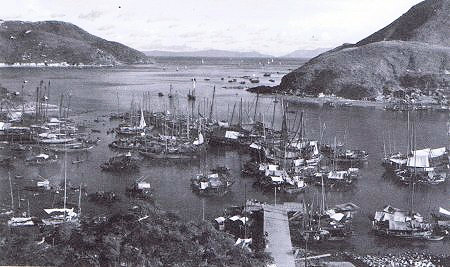 Maj Goring BHQ "We came across quite a good motor-boat----one of two belonging to the old HMS Cornflower.
Maj Goring BHQ "We came across quite a good motor-boat----one of two belonging to the old HMS Cornflower.
The Senior Naval Officer Aberdeen arrived and immediately offered us a battery.
While this was being brought, we foraged for food in the shell-wrecked huts and crippled shipping. Someone brought along a ten gallon drum of petrol. A little later three elderly merchant seamen and a young Merchant Service cadet Holger Christensen, came up and volunteered to act as our crew." [17]
Left The T-head pier by Staunton Creek.
Cdr Montague RN (Ret) SNO Aberdeen "I then left the dockyard and went to the pier near Staunton Creek to see how the salvage of C.410 and the scuttling of 'Robin' were progressing. The Japanese battery shelled the pier heavily and I was forced to take cover in a lighter." [1]
Ted Ross MoI “Although the white flag had been hoisted nearly an hour before, there was still heavy rifle and machine gun fire to be heard all around, and an occasional burst of artillery. Jap planes overhead were still dropping bombs.
I said to MacDougall “God, we can’t wait 4 or 5 hours” So we decided to take a chance on the small boat. We raced down there and I said to these guys “what’s wrong with the boat, can you get it going” and they said yes, all it needs is a battery. Another chap and I jumped back into the Buick and tore down to the naval store just along the road a bit and managed to dig up a battery and sixteen gallons of gas.
By the time we got back the other chaps had located a food dump and filled the boat with water, canned food of all kinds, rifles, pistols and ammunition. So we got the battery out of the Buick and left it standing beside the wharf intact and full of gas.” [28]
Capt Freddie Guest BHQ "We took a supply over to our hide-out, where the Admiral was, and we all managed to get a good tuck-in between the jobs. One never knew on a stunt like this where the next meal would come from, although the amount we had packed into the boat looked good for a couple of days at best." [29]
Adm Chan Chak ROC "We went on board the speed boat and left. It was 16:10 in the afternoon." [6]
Wearing their tin helmets they boarded the launch and prepared to cast off and navigate through the hundreds of junks sheltering in the vicinity of the Staunton Creek delta.
Sq-Ldr Max Oxford RAF "We found a motor boat which was thought capable of going to sea if it had petrol, we filled it up, put in water and food, called for a volunteer crew and set out in brilliant sunlight and a dead calm at about 6 knots." [30]
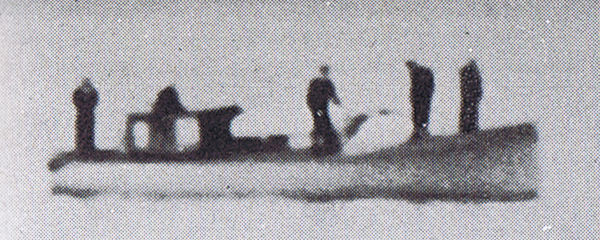
Capt Freddie Guest BHQ "We were now all set to go and, as the little engine started up it seemed like the roar of a motor-cycle without an exhaust. Progress was slow as the motor-boat
Left: The Cornflower II launch
was of six horse power and only capable of about five or six knots, so it seemed ages before we got clear of the harbour, chiefly due to the Danish engineer helmsman (Damsgaard) who was doing a miraculous piece of steering by finding his way through the sunken craft of all descriptions.
His next job was to get through the mass of Chinese fishing junks which had been forced to stay in harbour throughout the siege. This part of the harbour was simply packed with them." [29]
Ted Ross MoI “We finally got the battery and gasoline in and pushed off at a quarter to five.” [28]
Maj Goring BHQ "In due course we set off down the East channel, giving the West channel as wide a berth as possible, for it was not only full of wrecks but was the beaten zone of the eighteen-pounder guns which were firing down it." [17]
Cdr Montague RN (Ret) SNO Aberdeen "When the barrage of shells moved west I returned to the dockyard. Meanwhile the motorboat had left, but unfortunately chose to leave by the South East Channel." [1]
Capt Freddie Guest BHQ "The boat was only a twenty-five footer, so what with the food, water and petrol stores it was rather crowded. The Admiral and Colonel Yee went inside the cabin with most of the others. Peter Macmillan, Bill Robinson and I, crouched, down outside the cabin with the engineer, helmsman, and the crew." [29]
The launch was close to being gunwale-under as they proceeded away from the pier. Major Goring, the senior officer in the party assumed command, with master mariner Alexis (Alec) Damgaard, a tall slim Jutlander, at the helm. As they navigated through the mass of Junks Damsgaard knew that the small launch, over-loaded and over-crowded, would not survive in the open seas.
Maj Goring GOC3 BHQ "As commander of the party I told the coxswain to keep to the right of the channel, as close as he could to Ap Lei Chau, which I believed to be clear of Japanese. I thought it probable that the left bank of the channel, on the Brick hill promontory, was in enemy hands.
The coxswain, however, insisted on going to the left, because there was said to be another boat down there, the C.410, lying somewhere on the rocks, which he said would be a better craft for our purpose if we could get it off." [17]
Capt Freddie Guest BHQ "At last we cleared the harbour mouth and headed due south into the channel running between the Peninsula of Stanley, away to the east, and Brick Hill Point to the west." [29]
Just after entering the channel the Japanese now occupying a Pill Box at the south-west edge of Brick Hill, Nam Long Shan, they opened fire with rifles followed by a pair of 6.5mm light machine-guns.
Capt Freddie Guest BHQ "The channel widened rapidly the further we cruised, and we were soon leaving Brick Hill Point behind us. It was all very quiet except for the throb of the engine and I was beginning to think we were safe, at least from the land, when suddenly through the stillness of that lovely evening, there came a crack of a single shot, quickly followed by another.
In the next second came the frightening rattle of a machine-gun." [29]
Lt-Cmd Hsu Heng (Henry) ROC "We had not even gone out of the harbour at that time and we got attacked by the Jap's." [7]
Capt Freddie Guest BHQ "We stared at one another with startled looks and I yelled; “My God! Sighting shots,” as indeed they were, and in the next second came the frightening rattle of a machine-gun. Their first burst was just short of the target which caused the water to splash only a few yards away, thereby giving them their range. The second burst hit the Danish engineer (Damsgaard), poor fellow, who fell on me riddled with bullets. It also succeeded in hitting the petrol tank which made the engine give out immediately.
The next burst hit two more of the crew (Forster & Harley) and they, too, were in a bad way, if not dead. I received a splinter in my face. I bled profusely." [29]
Sq-Ldr Max Oxford RAF "After ten minutes we were greeted by rifle fire, followed by machine gunning, the engine was hit and there we lay between Hong Kong and Aberdeen Island with bullets ripping through the boat. We took to the water and swam in a hail of fire about 600 yards to the island." [30]
David MacDougall MoI "It was then 16:45 and in a few seconds it seemed every rifle and machine gun in the Japanese army had opened fire on us. The bullets came through the flimsy wooden hull as if it were paper; and presently they opened up with artillery as well.
The man next to me (Damsgaard) had his knee smashed, another got one in the stomach, the Chinese leader had his wrist shot away, and one or two (I couldn't see how many) collapsed and lay still. We were crouching in the bottom of the boat holding onto our tin hats." [26]
Maj Goring GOC3 BHQ "We had not gone far when the enemy opened up on us at sea level with two machine - guns and about forty rifles." [17]
Cdr Montague RN (Ret) SNO Aberdeen "They came under heavy fire from the Japanese who had captured the A/A battery on the South West Point of Brick Hill. The boat was riddled and disabled." [1]
David MacDougall MoI "Some immense force struck me a paralyzing blow and for a moment I didn’t know what had happened until, rolling over, I saw my own blood trickling down the deck. Before I had quite taken this all in another bullet went clean through my steel hat and a third clipped the sole of my shoe. Neither touched me.
A few seconds later a machine gun burst silenced the engine and we were thus left drifting helplessly about 200 yards from the shore under intense fire." [26]
With the engine disabled the launch drifted further down Aberdeen Channel coming under more intense machine-gun fire.
Another few minutes and the launch would have been beyond the range of the guns trained on them from ground level. As it was they were near the end of Aberdeen Channel, and drifting out into open water rapidly when they abandoned the launch,.
Ted Ross MOI "Well, we hadn't gone much more than five or six hundred yards when we were spotted from the shore and the Jap's let fly at us with everything they had, rifles, machine guns and small shells. The bullets simply whizzed through the side of the boat as if there had been no side there at all.
Several of our chaps were hit, and soon a shot put the engine out of commission, that capped it. There we were, just sitting like ducks on a pond.
The machine gun bullets kept tearing in. Mac got one right in his tin hat, another cut through the sole of his shoe, and just as he was saying how close they were coming he got one right in the back." [28]
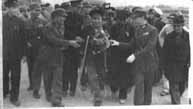

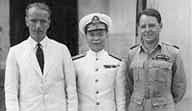




 L/S Les Barker (MTB 11) "We hid behind Aberdeen, on the western end of Hong Kong Island until nightfall, camouflaged under trees which hung into the water."
L/S Les Barker (MTB 11) "We hid behind Aberdeen, on the western end of Hong Kong Island until nightfall, camouflaged under trees which hung into the water." 




